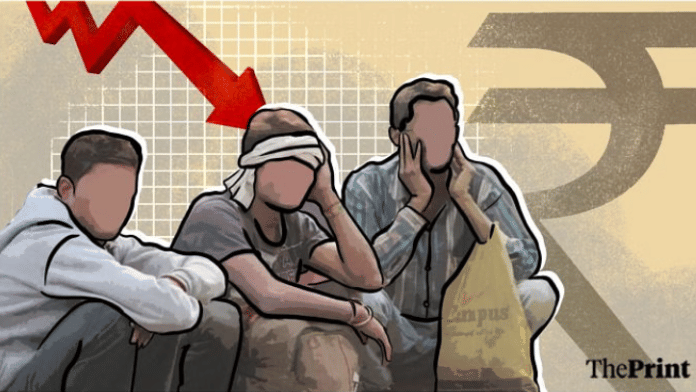Thank you dear subscribers, we are overwhelmed with your response.
Your Turn is a unique section from ThePrint featuring points of view from its subscribers. If you are a subscriber, have a point of view, please send it to us. If not, do subscribe here: https://theprint.in/subscribe/
Poverty has always been more than just the absence of money; it is about the absence of dignity, security, and the ability to live a minimally decent life. Yet, how poverty is measured varies greatly across countries. Most official poverty lines are either too narrow (India), outdated (USA), or relative (Europe). A more meaningful approach would be to define poverty in terms of basic needs as appropriate to each nation’s economy.
Using national economy as a base line, in a low-income country: “basic needs” might mean calories, clean water, basic shelter, primary education. In a middle-income country like India: needs should expand to include secondary education, basic healthcare, electricity, digital access, transport, sanitation. In a high-income country: needs would cover higher education, internet, healthcare insurance, social participation, safe housing.
So the “poverty line” is relative to what a person must have to live a minimally dignified life in that economy. A comparison of India, USA and Europe may read as follows: –
| Basic Need | India | USA | Europe (EU avg.) |
|---|---|---|---|
| Food & Nutrition | 2,100–2,400 calories/day; affordable staples (rice, wheat, pulses, vegetables, milk) | Nutritious USDA diet; balanced protein, fruits, fresh produce | Balanced EU diet with protein, dairy, fruits, vegetables |
| Housing | Pucca house with electricity, clean water, toilet | Safe housing with utilities, heating/cooling, running water | Heated housing with utilities, safe neighborhood |
| Education | At least up to Class 10 (secondary school) | High school completion, digital literacy | Secondary completion + digital access |
| Healthcare | Access to basic healthcare (govt. or private) | Health insurance or Medicaid; out-of-pocket affordability | Universal healthcare access, limited out-of-pocket |
| Energy | Electricity + LPG/clean cooking fuel | Electricity, heating/cooling, appliances | Electricity + heating (mandatory for winters) |
| Digital Access | Mobile phone + basic internet | Smartphone + broadband internet | Smartphone + broadband internet |
| Transport | Public transport or 2-wheeler | Public transport or at least 1 car per household | Public transport pass or shared car |
| Social Participation | Minimum: festivals, small savings | Ability to pay bills, recreation, small holidays | Leisure, 1 holiday/year, cultural participation |
Needs are multidimensional (nutrition, health, housing, education, dignity, safety). To capture this, we’d need a multidimensional index (like UNDP’s MPI), not a single “poverty line.” These are more complex to calculate, update, and compare across countries.India has put in some efforts do use need-based approaches like the Tendulkar Committee (2009) tried to base the poverty line on minimum calorie needs, clothing, rent, education, health. But it was criticized as too low. NITI Aayog’s Multidimensional Poverty Index (2021–23) also consideedr health, education, and living standards — which is closer to a needs-based approach. Likewise, Europe’s material deprivation indicators (like ability to afford heating, protein food, holidays, washing machine) are explicitly needs-based. But poverty lines are not purely needs-based because needs are subjective, dynamic, and politically sensitive. But modern approaches (like multidimensional poverty) are slowly moving in that direction, beyond just income/consumption.
In India, official poverty measurement is based on minimal calorie consumption or the World Bank’s $2.15/day threshold. This dramatically underestimates deprivation, since families earning above this line still lack access to electricity, internet, or secondary education. In reality, a family of four today requires nearly ₹30,000 a month to meet essential needs, while the official poverty line is less than half of that.
The U.S. uses an absolute poverty line set in the 1960s, updated only for inflation. This means a family of four earning $30,000 annually is considered “not poor,” even though the cost of housing, healthcare, childcare, and transport makes such an income deeply insufficient. A needs-based calculation would suggest a minimum of $120,000 a year for a family to live decently.
Europe is somewhat closer to reality. The EU uses a relative poverty line (60% of median income) alongside material deprivation indicators (e.g., ability to heat one’s home, take a holiday, or buy nutritious food). This framework better reflects changing social expectations and provides a more humane picture of poverty. Still, a needs-based approach indicates that poverty in Europe is underestimated as well.
Conclusion
A poverty line should not merely define survival; it should reflect what a society regards as a minimum dignified standard of living. Defining poverty based on basic needs within a national economy would give a more accurate, humane, and policy-relevant picture. This shift would expose the hidden poor in India and the U.S., while validating Europe’s move towards multidimensional and relative measures.
Col KL Viswanathan
(The author is an Indian Army veteran and a contemporary affairs commentator. The views are personal. He can be reached at kl.viswanathan@gmail.com )
These pieces are being published as they have been received – they have not been edited/fact-checked by ThePrint.


